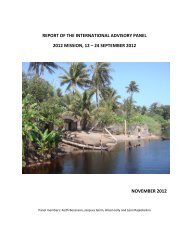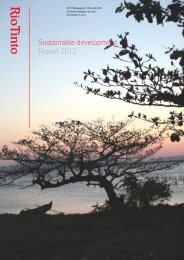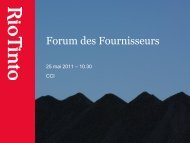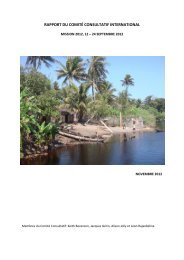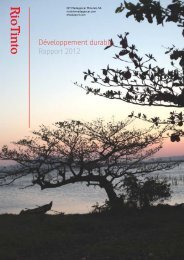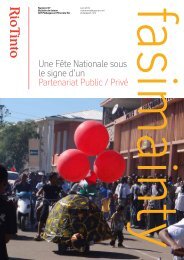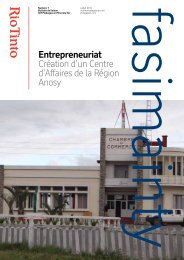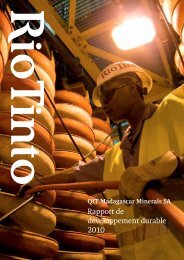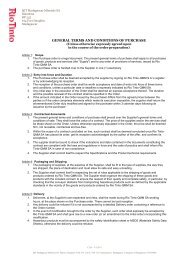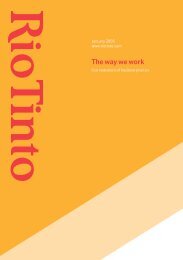Tracking Development - Rio Tinto - Qit Madagascar Minerals
Tracking Development - Rio Tinto - Qit Madagascar Minerals
Tracking Development - Rio Tinto - Qit Madagascar Minerals
Create successful ePaper yourself
Turn your PDF publications into a flip-book with our unique Google optimized e-Paper software.
The construction Phase<br />
Through close consultations with the affected communities<br />
and support from the government and the World Bank, most<br />
of the issues have been resolved. All claims for compensation<br />
have been investigated and 91.5 per cent of the claims have<br />
been settled. From the beginning, QMM stressed the objective<br />
of the resettlement programme was more than to simply<br />
provide cash or in-kind compensation for the loss of land or<br />
assets, but to ensure livelihoods were restored, if not improved.<br />
Livelihood restoration projects have since been implemented<br />
in collaboration with Cielo Terra, the regional government, the<br />
World Bank and QMM to increase literacy, improve fishing,<br />
aquaculture, agriculture and develop handicraft production.<br />
Community health initiatives have also been implemented<br />
and infrastructure built, including wells, latrines, a community<br />
drugstore, a basic health centre and a training centre.<br />
A Weir and the Andrakaraka Fishermen<br />
Part of the infrastructure included the construction of a weir in<br />
the lagoons downstream from lake Ambavarano. During the<br />
extraction and separation of minerals from sand, fresh water<br />
is used. The weir was built to prevent salt-water intrusion<br />
into the lagoon system, from where water is pumped to the<br />
mineral separation plant (MSP). This infrastructure also allows<br />
future restoration efforts to take place, as salt water cannot be<br />
used for replanted forests and fuel-wood plantations.<br />
The Ambavarano lake and lagoon system is important in the<br />
daily lives of surrounding communities, who fish from the lake<br />
and use the water system to access the ocean. To identify<br />
users and stakeholders, define issues and impacts and develop<br />
a management plan and communication strategy, an impact<br />
assessment was undertaken with the various stakeholders.<br />
To accommodate local fishing boats and tourist vessels, a lock<br />
was built as per suggestions from stakeholders’.<br />
The weir has been a point of dispute for some stakeholders.<br />
The new infrastructure has been perceived to restrict<br />
movement, while contributing to diminished fish intake.<br />
To investigate these grievances, extensive surveys were<br />
commissioned. Studies tracked and recorded species variety<br />
and quantity and the lagoon system users. Restricting the<br />
natural flow of water, the weir changed the lake and lagoon<br />
ecosystem from a brackish ecosystem to a freshwater<br />
ecosystem, which has in turn influenced the aquatic species<br />
living in the system. Certain species thrive, while others<br />
decline in the new freshwater system. The surveys also<br />
discovered fishermen increased by three-fold during the<br />
study period, which has contributed to overfishing.<br />
Measures were established to mitigate many of the weir’s<br />
impacts. To strengthen technical capacities and enhance<br />
intake, theoretical and practical training was offered to users.<br />
New regulation fishing nets were distributed, as the previous<br />
use of small mesh nets contributed to reduced fish numbers<br />
and environmental damage. Microfilament rope, weighing<br />
scales and traps were provided. Fibreglass pirogues and<br />
motors were supplied, with trainings conducted on motor<br />
maintenance and use. An association of fishermen from<br />
Andrakaraka, FIMIRA, was formed to manage the lagoon<br />
system. Eighty-four lake and sea fishermen benefited from<br />
the initial project.<br />
Transition to sustainable fishing practices has not been easy,<br />
particularly the use of large mesh nets and initial neglect of<br />
women’s roles in marketing the fish. However, continuing<br />
dialogue with the fishermen and an increase in fish stocks are<br />
addressing the remaining points of dispute. The Programme<br />
de Développement Intégré (PDI, or Integrated <strong>Development</strong><br />
Programme) is currently being implemented to mitigate impacts<br />
of the weir and ensure the affected population continues to<br />
receive support.<br />
33



